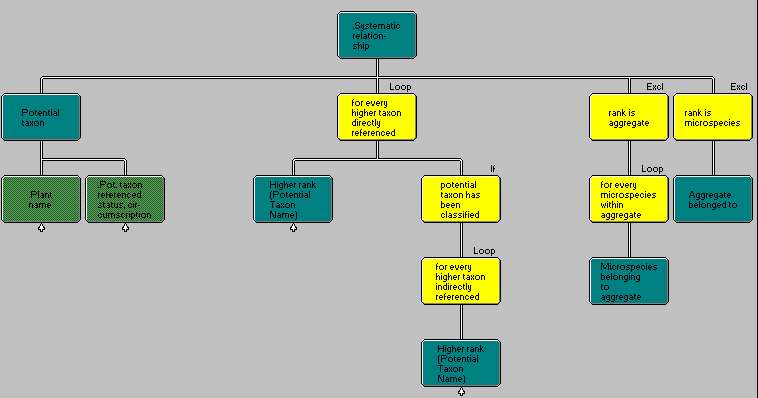
The term is here understood as "the placing of a plant (or group of plants) in groups or categories according to a particular plan or sequence .." (Lawrence, 1951). The aims of the model are restricted to the recording of the results of a classification process, rather than the process that lead to the results. Moreover, plant groups rather than individual plants or specimens are to be classified. Therefore, classification in the model's context is defined as the assignment of taxa to other taxa of higher rank.
Classifications relate to potential taxa, not to names. The source of the classifications is the reference defining the potential taxon, i.e. the reference assigning an accepted system status to a name. As a consequence, a new classification of a taxon creates a new potential taxon.

Diagram 10: Datastructure of systematic relationships
Most present taxonomic databases follow a pragmatic data model which is based on a fixed hierarchical classification according to a defined system of higher taxa. The IOPI checklist is in fact based on that assumption. However, the present model takes a broader approach, made possible by the potential taxon concept. The aim is to keep the model open for any view expressed by references used to build the database. An unlimited number of classifications must be possible. Thus, in this model a potential taxon may be classified as belonging to any potential taxon of higher rank (one of each rank). This arrangement makes sure that information extracted from publications or imported from other databases can be completely incorporated, even if only an incomplete hierarchy is presented. The program based on the datamodel may be used to restrict these possibilities, e.g. for the editing process. The use of a specific classification may be enforced (e.g. the Kew List of Genera, Brummitt 1992, for the initial edition of the IOPI checklist) and the input of a complete classification hierarchy, or of specific levels (e.g. families for spermatophytes) may be required from the user in the process of manual data entry.
A specific classification system may prescribe a defined sequence of taxa. Output from the database may follow this sequence. For sorting purposes, an attribute for a systematic sequence number ("phylogenetic sequence number", Sinnot 1993) must be included within the potential taxon entity. The specific taxon must "inherit" the overall position of the higher taxon it was classified into. The sequence number may therefore consist of either a single number (sorting would have to lookup classification relationships from the top) or an index directly mirroring the overall classification.

Diagram 11: Classification
The entity „Classification intersection" has two attributes: A pointer to the name of the potential taxon to be classified and a pointer to the name of the potential taxon higher in rank to which it belongs. The classification reference according to which this assignment was made is provided by the reference for the accepted status of the former potential taxon.
Next chapter; Contents of this article; Complete entity list; References cited; Author information. Last updated: June 23, 1995